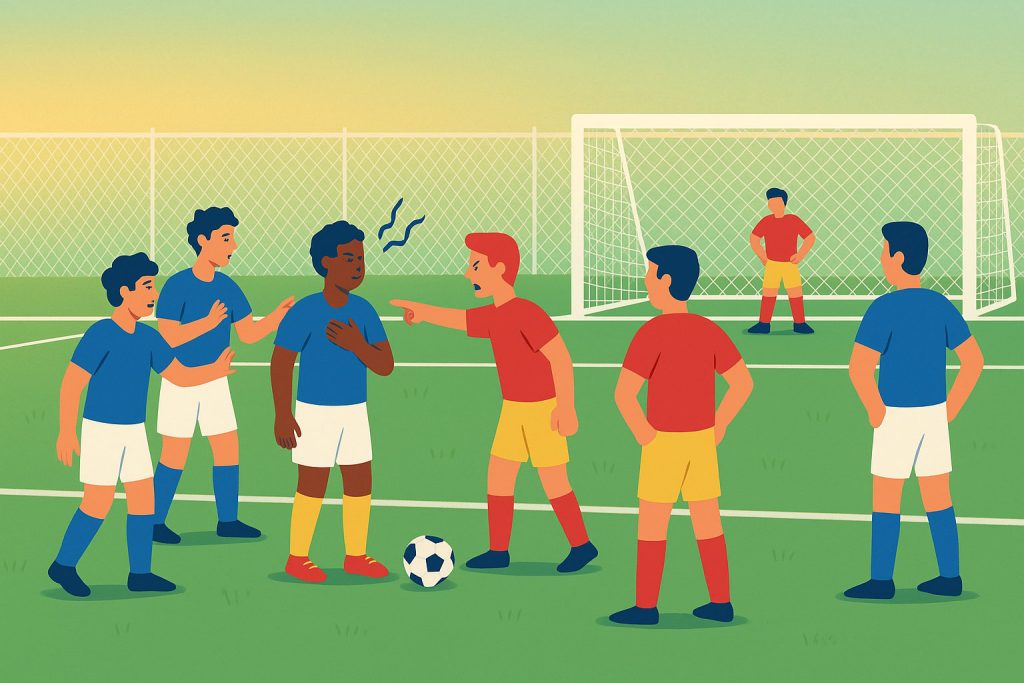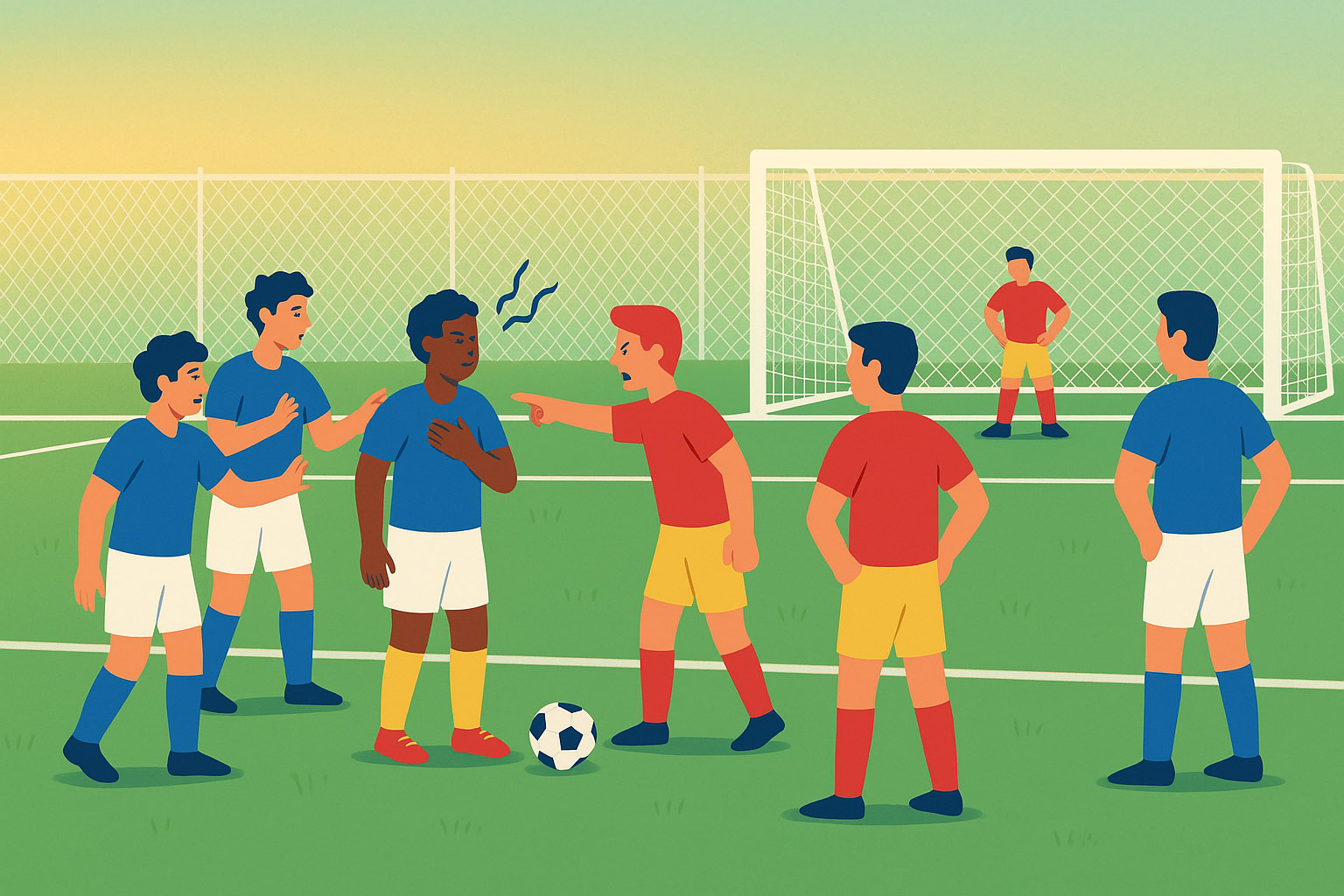Although sport has the power to connect people, racism remains a persistent issue in the world of sports. Think of racist chants from the tribunes, but also of more ‘subtle’ racist remarks that can be deeply harmful. How do you recognise racism in sports, and what can you do about it? In this blog, we’ll explore this using the four forms of Oppression – the 4I’s – and discuss how you can take action against racism. Let’s dive in!
Four forms of oppression and racism
Before diving into racism in sports, it’s helpful to understand The 4 I’s of Oppression in relation to racism. This model shows how inequality exists and is maintained in society:
- Ideological racism: Racist beliefs that justify the marginalization, exploitation, or harm of certain groups of people. The normalisation of these ideas keeps racism alive. For example: The belief that one group of people is more intelligent than another, based on characteristics like skin colour, background, and/or religion.
- Institutional racism: The ways in which ideological racism shapes the rules of society – in education, healthcare, politics, the labour- and housing markets. For example: The Dutch childcare benefits scandal, in which thousands of parents were wrongfully accused of fraud based on their ethnic background.
- Interpersonal racism: Racism between people. Think of racist comments or excluding people based on their skin colour, background, and/or religion. For example: Saying ‘You speak English very well!’ to a person of colour, assuming that, because of their skin colour, they are less likely to speak English fluently or at all.
- Internalized racism: When Black people or people of colour internalize the belief that they are inferior to the dominant group – white people. For example: A child of colour believing they will never be successful.
These four forms of racism are also visible in the world of sports. Read on to discover how!
Stereotypes about athletes of colour
Black athletes and athletes of colour are often confronted with racist stereotypes. These have a major impact on their career opportunities and mental health. Sports journalists and media, for example, often emphasise the physical qualities of these athletes, suggesting that they possess such traits ‘naturally’ due to their skin colour or background. This is a form of ideological racism: stereotypical ideas about certain groups based on ethnicity or race. These ideas are (unconsciously)also reinforced by the media.
You might think: ‘Isn’t it a compliment to mention someone’s physical strength’ But in reality, this impacts how these athletes are perceived and evaluated. It contrasts with how white athletes are often portrayed – in more diverse ways, such as being praised for strategic thinking, leadership, or creativity. The one-dimensional portrayal of athletes of colour in turn can also negatively affect their well-being.
Impact of racist stereotypes
The impact of these stereotypes is big and manifests in various ways. For example, Black athletes are offered fewer leadership opportunities after their athletic careers, due to persistent stereotypes about who is suitable for such roles. Club owners mainly view them through a stereotypical lens, which puts them at a disadvantage compared to their white colleagues.
Additionally, many sports organisations lack (active) antiracism policies. This results in the underrepresentation of people of colour in leadership positions and is a form of institutional racism, upheld amongst other things by the media and sports institutions.
Another harmful form of institutional racism involves rules that directly disadvantage athletes of marginalised communities. One example is the hijab ban in French sports – a measure that Amnesty International views as a human rights violation.
On an interpersonal level, athletes of colour often experience racist comments and behaviour from teammates and fans. In addition to overt chants, there are more ‘subtle’ forms, such as microaggressions. For example: ‘You played so well! But hey, it’s in your nature, right?’ These kinds of remarks suggest that success is purely due to innate traits rather than hard work and skill.
Racism is also common in amateur sports clubs. 47% of people with a migration background in sports clubs in the Netherlands report experiencing negative behaviour such as microaggressions, misunderstanding, name-calling, exclusion, and even physical violence. In reality, this percentage is likely higher, as many incidents go unreported due to fear or the belief that reporting won’t make a difference.
Constant exposure to racism can lead to internalised racism. Athletes of colour may start believing the racist stereotypes themselves, which damages their confidence and ambition. It affects both their mental and physical health. In this way, racism not only limits visible opportunities on the field or in boardrooms, but also deeply impacts the personal experiences of athletes.
What can you do?
To tackle racism in sports, the social norm within the sports world must shift. It’s important not to look away when witnessing racism, but to act. Especially people who do not experience racism themselves can take on this responsibility. Here’s how:
- Step in with the 5D-method: Witnessing racism on or around the field? Step in in a way that feels right for you. Distract from the situation, ask a coach for help (Delegate), or check in with the person affected afterwards (Delay). Every action helps and shows that this behaviour is not acceptable.
Want to learn more about bystander intervention in cases of racism? Join our Together Against Racism training! - Report racist incidents: Report racist incidents to your sports club or a reporting point like discriminatie.nl. Most reporting points also offer support if the incident happened to you.
- Start the conversation about antiracism in your club: Change starts with dialogue. Bring up antiracism at your club and make it a recurring topic in meetings. This creates space for awareness and action.
- Organise antiracism activities at your club: Set up conversations, host a Together against racism training, or launch an antiracism campaign. Be creative and ask fellow athletes for help!
- Address your club’s antiracism policy: Ask if your club has a policy in place. If not, advocate for one. This can include behavioural guidelines, a reporting point within the club, and trainings for board members, coaches, and players.
- Keep learning: Everyone has unconscious biases. Keep educating yourself about what racism (in sports) is, and what your role in it might be. The more you know, the better you can recognise racism – and take action against it, starting with one of the options above!
Now that you know what racism in sports looks like and what you can do, it’s time to take action. A social norm doesn’t change overnight, but every (small) action matters. Let’s harness the power of sport to make the world of sports a safe and inclusive place for everyone!
Want more background information? Read our blogs on what racism is and what racial microaggressions look like.
The information in this blog is based on the Together Against Racism training, developed by Fairspace and led by Sharon Chigozie Ubani.
Sources:
- https://www.amnesty-international.be/nieuws/frankrijk-hijab-verbod-bij-sport-leidt-tot-mensenrechtenschendingen-en-racisme
- https://www.trec.org/wp-content/uploads/2021/08/The-Four-Is-of-Oppression-v821.pdf
- https://schooltv.nl/video-item/hoe-uit-racisme-zich-in-sport-zwarte-sporters-worden-anders-beschreven-dan-witte-sporters
- https://www.verwey-jonker.nl/wp-content/uploads/2023/12/222430_Verkenning-discriminatie-en-rascisme-sport-cultuur.pdf
- https://www.kennisbanksportenbewegen.nl/?file=10585&m=1639146543&action=file.download
- https://www.scp.nl/publicaties/publicaties/2020/04/02/ervaren-discriminatie-in-nederland-ii

